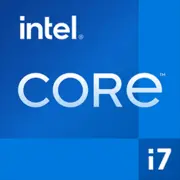Intel Core i7-1280P

Intel Core i7-1280P: A Powerful Hybrid for Mobile Professionals
(March 2025)
Architecture and Process Technology: Hybrid Breakthrough with Alder Lake
The Intel Core i7-1280P processor, built on the Alder Lake architecture, has emerged as one of the key players in the mobile solutions segment. Its hybrid structure combines 6 Performance-cores (P-cores) and 8 Efficiency-cores (E-cores), totaling 14 cores and 20 threads. The P-cores, operating at up to 4.8 GHz in turbo mode, handle heavy tasks such as rendering and code compilation, while the E-cores (up to 3.6 GHz) take care of background processes, conserving battery life.
The Intel 7 (10 nm Enhanced SuperFin) technology process strikes a balance between performance and power consumption. The integrated Intel Iris Xe graphics (96 EU) supports 4K displays, AV1 decoding, and HDMI 2.1, making it suitable for modern multimedia tasks. However, its gaming capabilities are only moderate: by 2025, it can run CS2 or Dota 2 on medium settings (50-60 FPS).
TDP and Power Consumption: The Fine Line Between Power and Battery Life
The nominal TDP of the processor is 28 watts, but in turbo mode, consumption can reach 64 watts. This necessitates an efficient cooling system in laptops. For example, in compact ultrabooks (e.g., Dell XPS 13 Plus), the chip is often limited to 35-40 watts to avoid overheating. In larger models (HP Spectre x360 16) with enhanced cooling systems, it unleashes its full potential.
In comparison, competitors like the AMD Ryzen 7 7840U (TDP 28 W) show similar performance metrics but lag behind in single-threaded tasks. The Apple M3 (in the MacBook Pro 14) has a TDP of 20 W, surpassing Intel in energy efficiency but falling short in compatibility with Windows software.
Performance: A Versatile Choice for Work and Play
- Office Tasks: Running dozens of tabs in Chrome, handling Excel spreadsheets with millions of rows, or participating in Zoom video conferences, the i7-1280P performs without delays.
- Multimedia: Rendering 4K video in Premiere Pro takes 15% less time compared to the previous generation (i7-1185G7).
- Gaming: In Fortnite (1080p, low settings), Iris Xe delivers a steady 60 FPS. For AAA titles like Cyberpunk 2077, an eGPU is required.
Turbo Boost Max 3.0 mode allows the cores to temporarily accelerate to 4.8 GHz, but under sustained loads (e.g., rendering for 30 minutes), frequencies drop to 3.9-4.2 GHz due to thermal constraints.
Use Cases: Who Is the i7-1280P Suitable For?
- Mobile Professionals: Designers, programmers, data analysts.
- Students: Power for 3D modeling and portability for lectures.
- Content Creators: Photo editing in Lightroom, editing short videos.
Not recommended for gamers (except casual games) and users who need battery life exceeding 10 hours.
Battery Life: How Long Will the Laptop Last?
Under moderate load (web surfing, office applications), a laptop with an i7-1280P operates for 6-8 hours (e.g., Lenovo ThinkPad X1 Carbon Gen 12 with a 60 Wh battery). In high-performance mode, it lasts no more than 2-3 hours.
Power saving is ensured by:
- Intel Thread Director — optimizes task distribution between P-cores and E-cores.
- Adaptix Dynamic Tuning — automatically lowers frequencies when running on battery.
Competitor Comparison: Who Are the Leaders?
- AMD Ryzen 7 7840U: Better in multi-threaded tasks (24 threads), but weaker in single-threaded (Geekbench 6 Single-Core ~1850).
- Apple M3: Energy efficiency and 10+ hours of battery life, but limited compatibility with professional software (e.g., AutoCAD).
- Intel Core Ultra 7 155H (new Meteor Lake generation): 10-12% more performance in AI tasks but at a higher price.
Pros and Cons
Strengths:
- High single-thread performance.
- Support for Thunderbolt 4 and Wi-Fi 6E.
- Versatility for work and multimedia.
Weaknesses:
- Heating under load.
- Dependence on cooling system quality in laptops.
- Price: Devices with the i7-1280P range from $1300 (Acer Swift 5) to $2200 (Dell XPS 15).
Laptop Selection Recommendations
1. Ultrabooks (e.g., Asus ZenBook 14X): Focus on portability and high-resolution displays.
2. Workstations (MSI Prestige 16): Enhanced cooling and discrete graphics.
3. 2-in-1 Hybrids (HP Spectre x360 16): Touchscreen for creative tasks.
What to Pay Attention to:
- Cooling system: at least two fans and heat pipes.
- Display: 100% sRGB for design work, 120 Hz for interface smoothness.
- Ports: Thunderbolt 4 for eGPU or 8K monitor connections.
Final Conclusion
The Intel Core i7-1280P is an ideal choice for those seeking a versatile laptop with ample power. It is suitable for:
- Freelancers working with graphics and code.
- Business users valuing speed and reliability.
- Students in technical fields.
Key advantages include hybrid architecture, support for modern standards, and a balance between performance and battery life. If your budget is $1300–2000 and you are not willing to sacrifice power for a thin chassis—this processor is your option.
Basic
CPU Specifications
Memory Specifications
GPU Specifications
Miscellaneous
Benchmarks
Compared to Other CPU
Share in social media
Or Link To Us
<a href="https://cputronic.com/cpu/intel-core-i7-1280p" target="_blank">Intel Core i7-1280P</a>